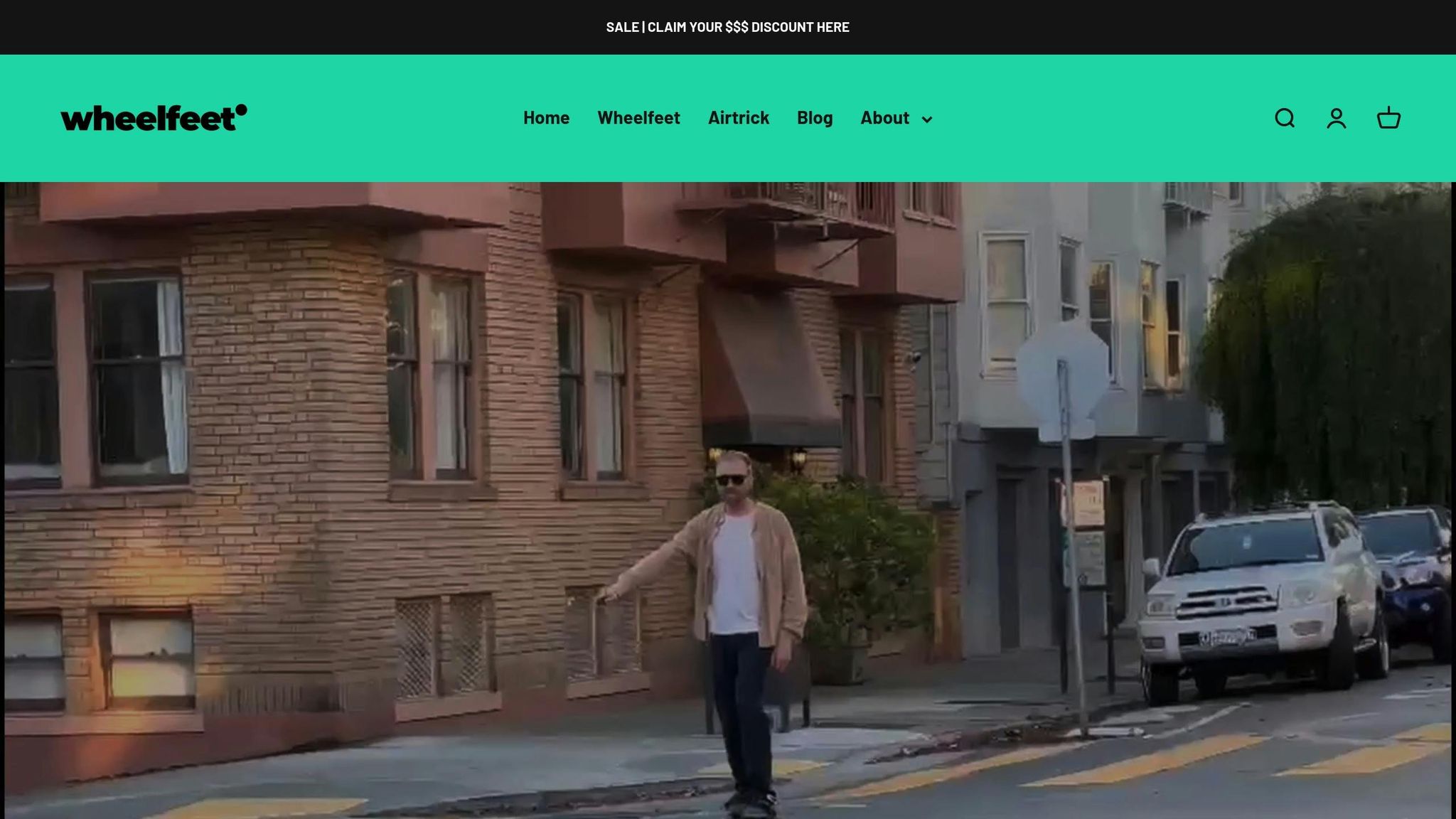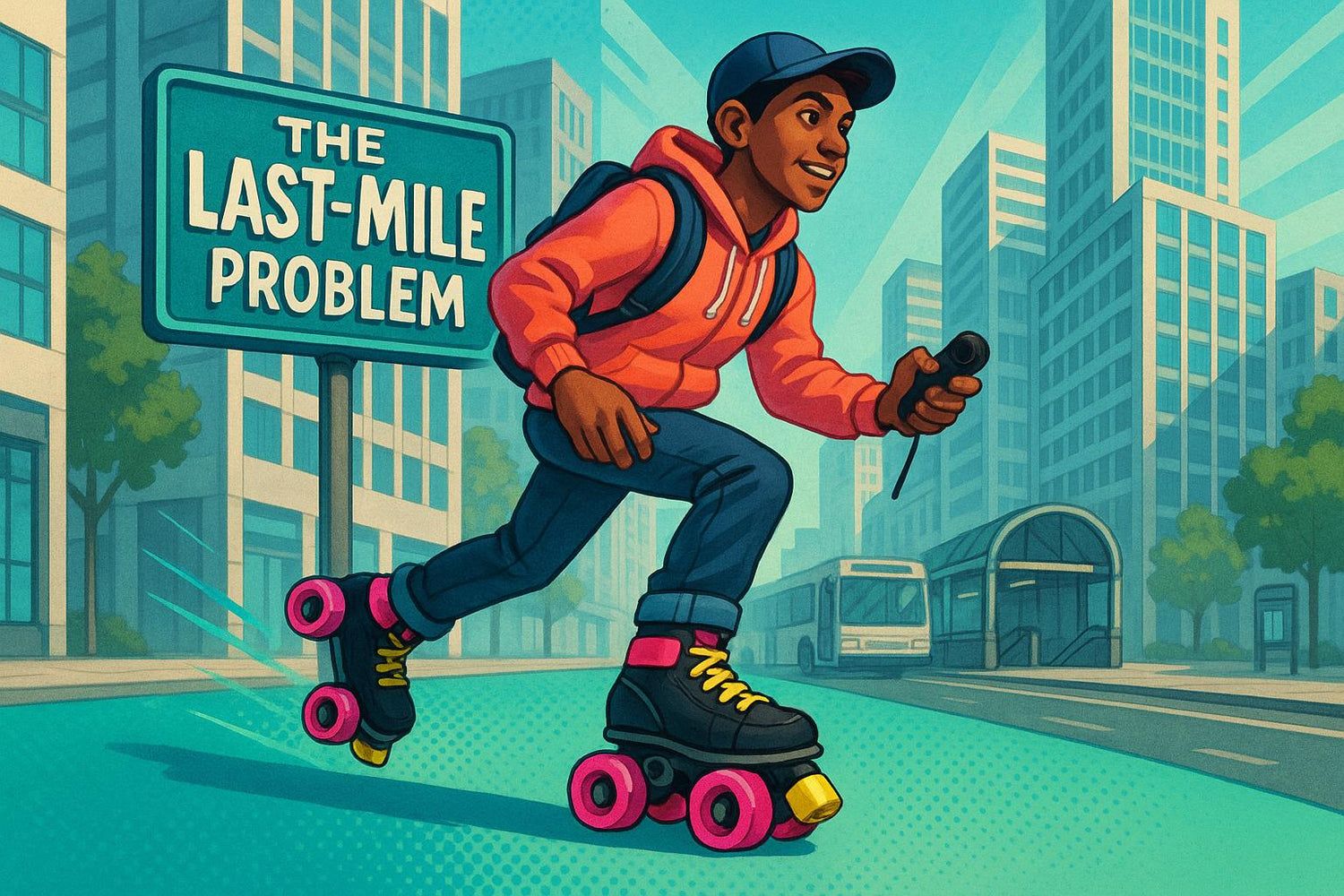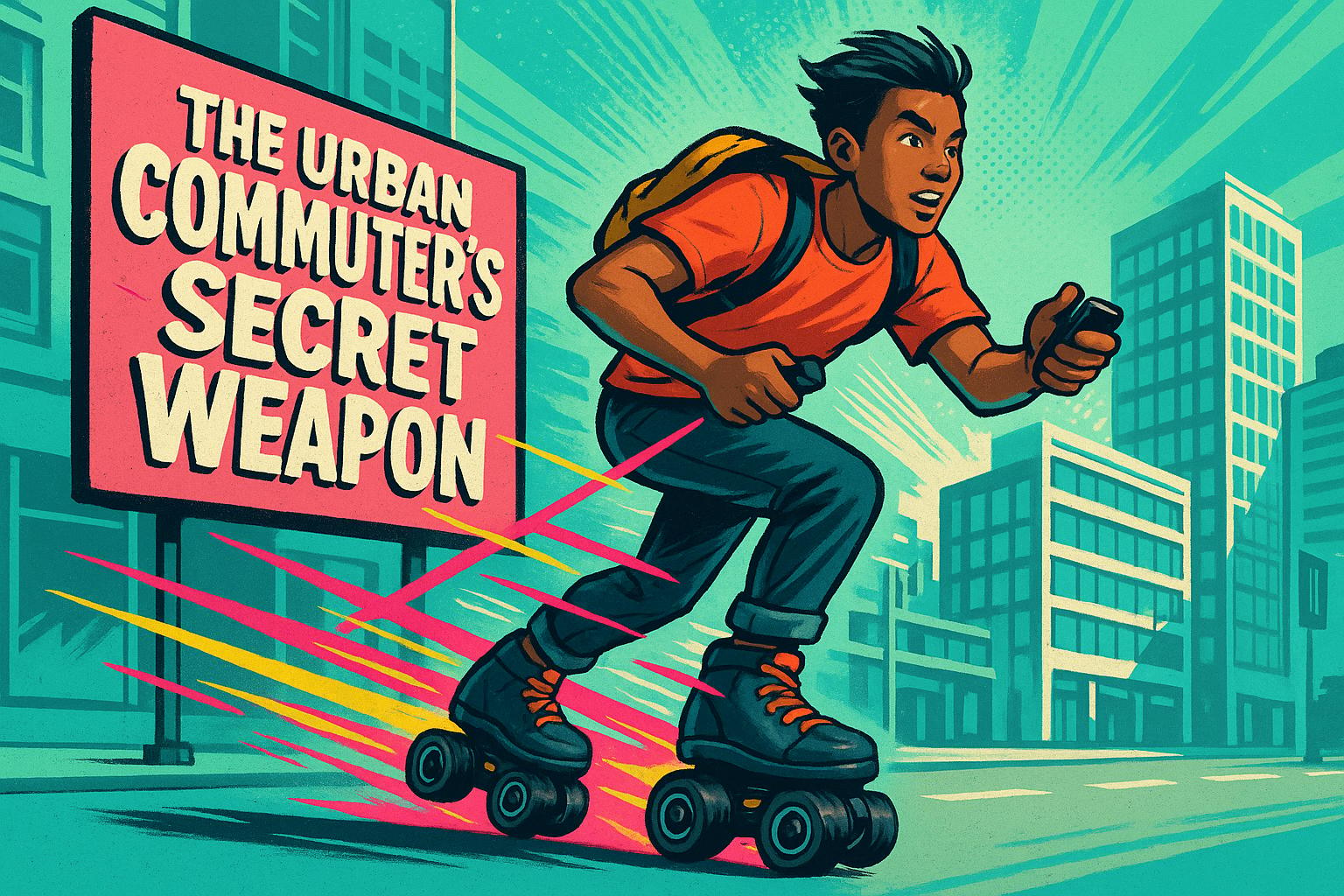The "last-mile" problem refers to the final stretch of your commute - from a transit stop to your actual destination. This seemingly small part of the journey often feels inefficient due to poor transit connections, limited walking infrastructure, and reliance on cars for short trips. These issues increase commute time, urban congestion, and emissions.
A new solution gaining traction is electric roller skates, like Wheelfeet. They’re portable, cost-effective, and eco-friendly, with features like speeds up to 15 mph, a 9-mile range, and regenerative braking. Unlike bikes or scooters, they’re easy to carry and store indoors, making them ideal for short urban trips. While weather and a slight learning curve may pose challenges, they offer a practical way to improve daily commutes while reducing car dependency.
The best electric scooters and personal EVs for your commute
Why Fixing the Last-Mile Problem Matters
Tackling the last-mile problem goes beyond solving a minor inconvenience - it has ripple effects on commuters, cities, and the environment. Addressing these inefficiencies is essential for improving urban transportation in the U.S.
How It Affects Daily Commuters
For commuters, the last leg of a journey often adds unnecessary time to their schedules. Poor last-mile connections force people to build in extra buffer time every day, which can feel like an ongoing drain on both time and money.
These inefficiencies can also make public transit less appealing. If the final part of your trip feels too frustrating or time-consuming, it’s tempting to skip transit altogether and stick with a personal vehicle. This shift undermines the benefits of mass transit systems, which are designed to reduce traffic and improve mobility.
Problems It Creates for Cities
When more people opt for personal vehicles due to last-mile challenges, cities face a host of new problems. Traffic congestion worsens, parking becomes harder to find - especially in crowded downtown areas - and valuable urban land gets tied up in parking lots rather than being used for housing, parks, or businesses.
Short car trips also take a toll on city budgets. Congestion slows down essential services and deliveries, while the extra wear and tear on roads leads to higher maintenance costs. Frequent construction projects to repair damaged roads only add to the disruption.
How Better Last-Mile Options Help the Environment
The environmental impact of last-mile inefficiencies is another pressing concern. Short car trips are particularly wasteful since vehicles often run less efficiently during these stretches, leading to higher emissions. Cutting down on these trips can significantly improve air quality, benefiting public health and reducing healthcare costs tied to pollution-related illnesses.
Shifting to on-demand and electric solutions for the last mile offers a cleaner alternative. When powered by renewable energy, these options produce zero direct emissions, helping to shrink the carbon footprint of urban transit systems. Better last-mile connectivity also encourages more compact urban development by making public transit hubs more accessible, reducing the need for sprawling, car-dependent infrastructure. These changes pave the way for creative solutions like electric roller skates and other forward-thinking innovations.
Electric Roller Skates: A Practical Solution
Electric roller skates offer a sleek, portable way to tackle the challenges of last-mile commuting. By combining electric propulsion with convenience, they address many of the frustrations faced by American commuters. Let’s break down how Wheelfeet skates, in particular, make this possible.
Key Features of Wheelfeet Electric Roller Skates

Wheelfeet electric roller skates are packed with features designed for urban mobility. They can reach speeds of up to 15 mph, significantly cutting travel time compared to walking or even traditional skating. With a range of up to 9 miles per charge, they’re perfect for most last-mile commutes in U.S. cities.
The skates include a regenerative braking system, which not only ensures smooth stops but also helps recharge the battery. A wireless remote control allows for precise speed adjustments, giving users full control over their ride.
Portability is another standout feature. These lightweight skates are easy to carry once you reach your destination, whether it’s an office, a shopping center, or a transit hub. They fit U.S. shoe sizes 6–13, making them accessible to a wide range of adults. Plus, the dual-mode functionality lets you switch to manual skating if the battery runs out, ensuring you’re never stranded.
How They Help with Last-Mile Commuting
These features come together to make Wheelfeet skates an efficient commuting tool. One of the biggest advantages is time savings. Instead of spending 10–15 minutes walking, you can cover the same distance in just 3–5 minutes.
Unlike bikes or scooters, which require parking and are often at risk of theft, you can carry your skates indoors. This is especially useful in busy downtown areas where secure parking is scarce.
From an environmental perspective, Wheelfeet skates also stand out. Introduced in November 2023, they were marketed as a green commuting option, helping users reduce their carbon footprint.
Cost is another area where these skates shine. At $599.00, they’re more affordable than many monthly parking passes in major cities. Plus, there are no fuel costs, minimal maintenance, and no need for insurance or registration.
Features and Considerations Comparison
Here’s a quick comparison of electric roller skates versus other commuting methods:
| Aspect | Electric Roller Skates | Walking | Rideshare |
|---|---|---|---|
| Speed | Up to 15 mph | 3–4 mph | Variable (traffic) |
| Range | 9 miles per charge | Unlimited | Unlimited |
| Upfront Cost | $599.00 | $0 | $0 |
| Ongoing Costs | Minimal electricity | $0 | $15–25 per ride |
| Portability | Easily carried | N/A | N/A |
| Weather Dependency | Moderate | Low | Low |
| Learning Curve | 1–2 weeks practice | None | None |
| Storage Requirements | None (carry with you) | N/A | N/A |
This table highlights why electric roller skates are a great fit for daily commuters who stick to a regular last-mile route. While there is a short learning curve, the time savings and long-term cost benefits outweigh this initial hurdle.
Of course, weather can be a limiting factor. Rain, snow, or icy conditions might make skating unsafe, so it’s wise to have a backup transportation plan. Still, for most days in urban areas, electric roller skates provide a reliable and efficient way to conquer last-mile commuting challenges.
sbb-itb-bf837b9
Adding Electric Roller Skates to Your Daily Commute
Thinking about incorporating Wheelfeet Electric Roller Skates into your daily routine? Here’s how to make the transition smooth and hassle-free.
Check If Your Route Works
Start by walking your route to identify the best paths. Look for smooth sidewalks, bike lanes, or paved trails, and take note of any obstacles like heavy foot traffic, steep hills, or construction areas. These factors can significantly impact your skating experience.
Next, measure the distance between transit stops and your destination. With a range of up to 9 miles per charge, ensure your skates can handle the trip without needing a recharge. If the distance exceeds the range, consider planning a charging stop or having a backup transportation option.
It’s also important to evaluate the accessibility of your destinations. Can you easily enter buildings, offices, or transit stations while wearing or carrying your skates? Some places may have specific rules about wheeled devices, so it’s a good idea to check these policies beforehand.
Lastly, test your route during different times of the day and in various weather conditions. Morning rush hour crowds or rainy and snowy weather can make skating less practical or even unsafe. Adjust your plans accordingly to ensure a comfortable and secure commute.
Once you’ve mapped out a suitable route, it’s time to focus on legal and safety considerations.
Know the Rules and Stay Safe
Before hitting the road, familiarize yourself with local regulations regarding personal mobility devices. Many areas apply the same rules for electric scooters or skateboards to roller skates. Check with local authorities for details on helmet requirements, speed limits, and designated travel zones.
Safety gear is non-negotiable. Always wear a helmet, and consider adding knee and elbow pads along with reflective clothing or accessories, especially if you’ll be skating in low-light conditions.
Spend some time practicing in a safe environment, like an empty parking lot or a quiet neighborhood street. Get comfortable with the wireless remote control, braking system, and turning at different speeds. When sharing space with pedestrians or other commuters, make eye contact and use clear signals to communicate your movements. This helps avoid misunderstandings and keeps everyone safe.
Once you’ve mastered safety, focus on managing your skates for daily use.
Managing Battery, Transport, and Storage
To keep your skates ready for action, establish a charging routine and monitor battery levels regularly. Avoid letting the battery completely drain, as this can affect its longevity.
When you’re not skating, the lightweight design makes it easy to carry your skates by hand or in a small bag. At your destination, find a secure and dry spot to store them - under a desk, in a locker, or in a designated storage area. Keeping them in a dry environment helps protect the battery from extreme temperatures.
It’s also smart to have a backup transportation plan for days when the weather doesn’t cooperate. Rain or snow can make skating unsafe, so having an alternative option ensures you’re not caught off guard.
Regular maintenance is crucial for reliable performance. Check the tire pressure, clean the wheels after exposure to dirt or water, and inspect key components like the remote control battery and braking system. These simple upkeep steps can help prevent unexpected issues and ensure your skates are always ready to roll.
Conclusion: Solving Last-Mile Problems with Electric Roller Skates
Navigating the gap between transit stops and final destinations can be a frustrating part of urban commuting. Walking takes time, and rideshares often feel like overkill for short distances. Enter electric roller skates - a practical solution to bridge these "last-mile" challenges.
Take Wheelfeet Electric Roller Skates, for example. They make covering that final stretch quick and easy, cutting down travel time and improving the efficiency of your overall commute. This isn't just about individual convenience; it also helps create a smoother, more connected urban transportation system.
Switching short trips from cars to electric roller skates can help ease traffic congestion, cut down on emissions, and promote a cleaner, greener cityscape. In bustling American cities, integrating these micromobility options into transit networks could be a game-changer for sustainable urban living.
However, making the most of this technology requires some preparation. Plan your routes wisely, stay informed about local laws, and always prioritize safety while riding. By taking these steps, you can seamlessly add electric roller skates to your daily routine. As more people adopt this mode of transport, cities across the U.S. could see a future that's faster, cleaner, and a whole lot more fun - one skate at a time.
FAQs
What are the key benefits of using Wheelfeet electric roller skates for your last-mile commute?
Wheelfeet electric roller skates transform your last-mile commute into a quicker, smoother, and more enjoyable experience. Say goodbye to traffic jams and long walks - these skates help you get where you need to go with ease and efficiency.
Beyond their sleek design, these skates are lightweight, easy to carry, and built for convenience. Whether you're heading to work, picking up groceries, or making your way to the train station, they provide a fun, eco-conscious way to travel while saving both time and energy.
How do electric roller skates make last-mile commuting more affordable and convenient?
Electric roller skates are an exciting option for last-mile commuting, offering both affordability and convenience. Unlike rideshares or public transit, they don’t come with recurring expenses like fares or fuel, which makes them a more budget-friendly choice in the long run. Plus, their compact size means you can easily tuck them away in your office, bring them home, or even carry them onto public transportation without any hassle.
These skates also save you time. With speeds of up to 10–12 mph, they let you zip through crowded streets or cover short distances much quicker than walking. And as an added bonus, they help reduce your carbon footprint. For anyone looking for a practical, eco-conscious, and wallet-friendly way to solve the last-mile commute, electric roller skates are worth considering.
What safety precautions and legal requirements should I know before using electric roller skates in my area?
Before hopping on your electric roller skates, it’s important to know the local laws and safety rules. Take note of speed limits, whether you’re allowed to use them on sidewalks or bike lanes, and if helmets or other protective gear are required.
Some areas might have additional regulations, like restrictions on where you can ride or even requirements for registration or insurance. Staying up to date with these rules ensures you can enjoy your ride safely and without running into any legal issues.




Leave a comment
All comments are moderated before being published.
This site is protected by hCaptcha and the hCaptcha Privacy Policy and Terms of Service apply.